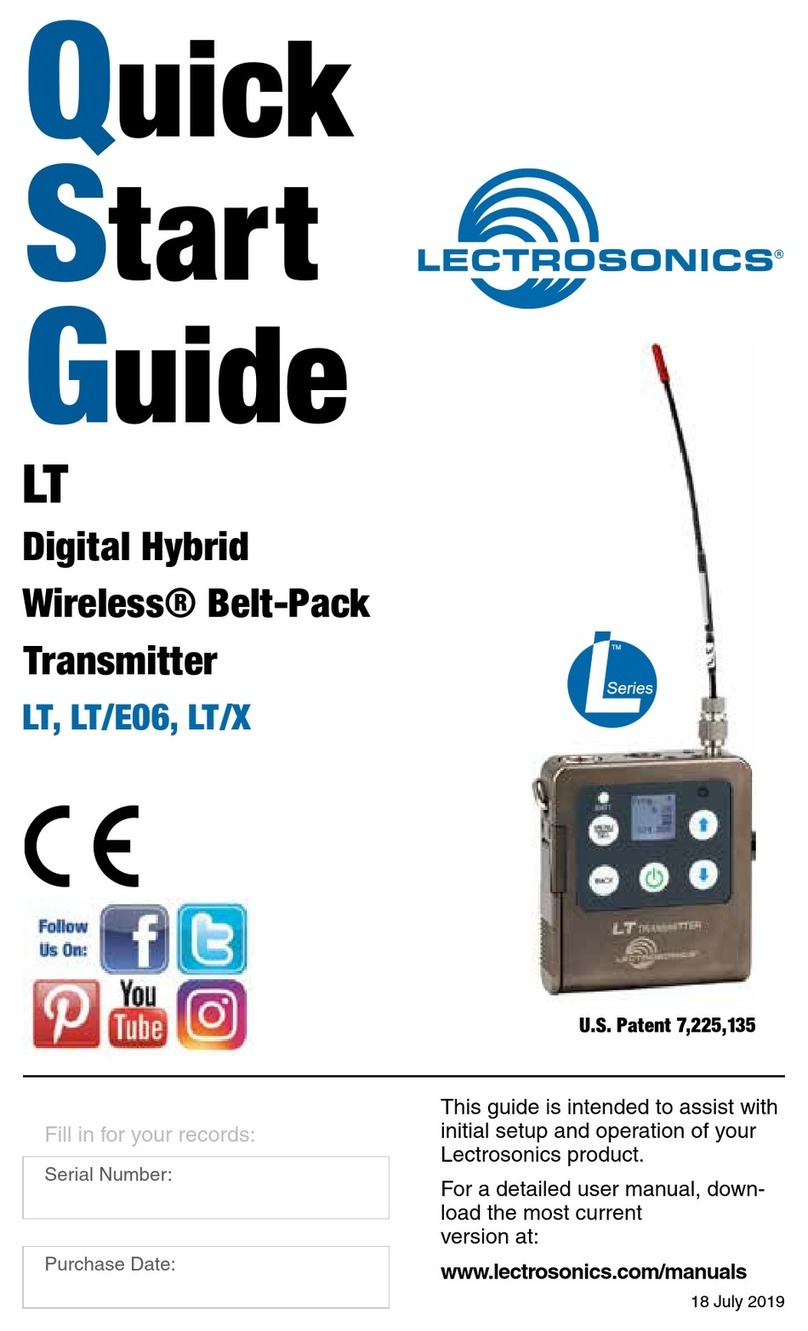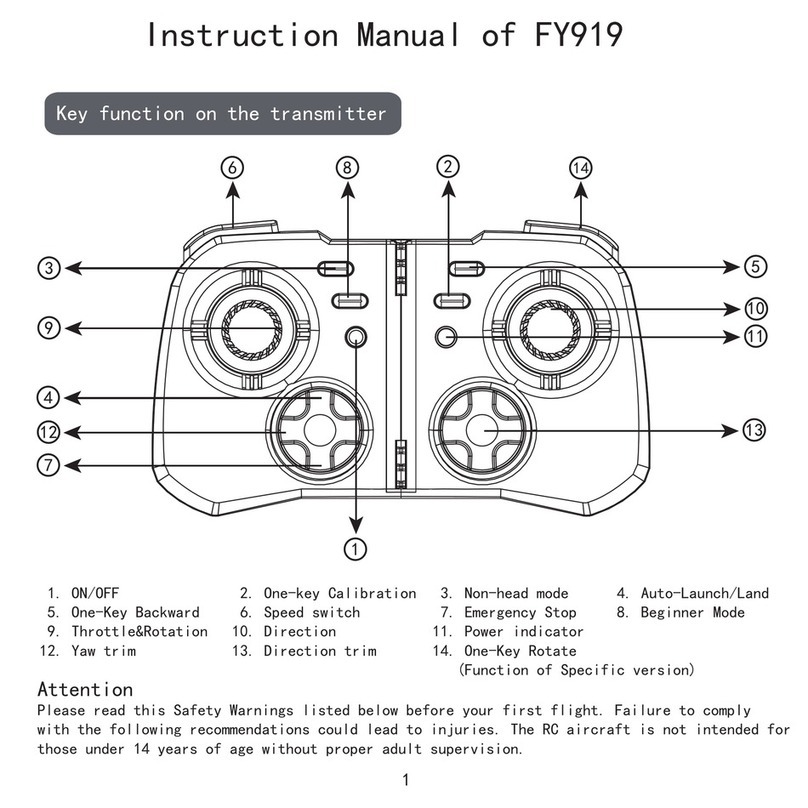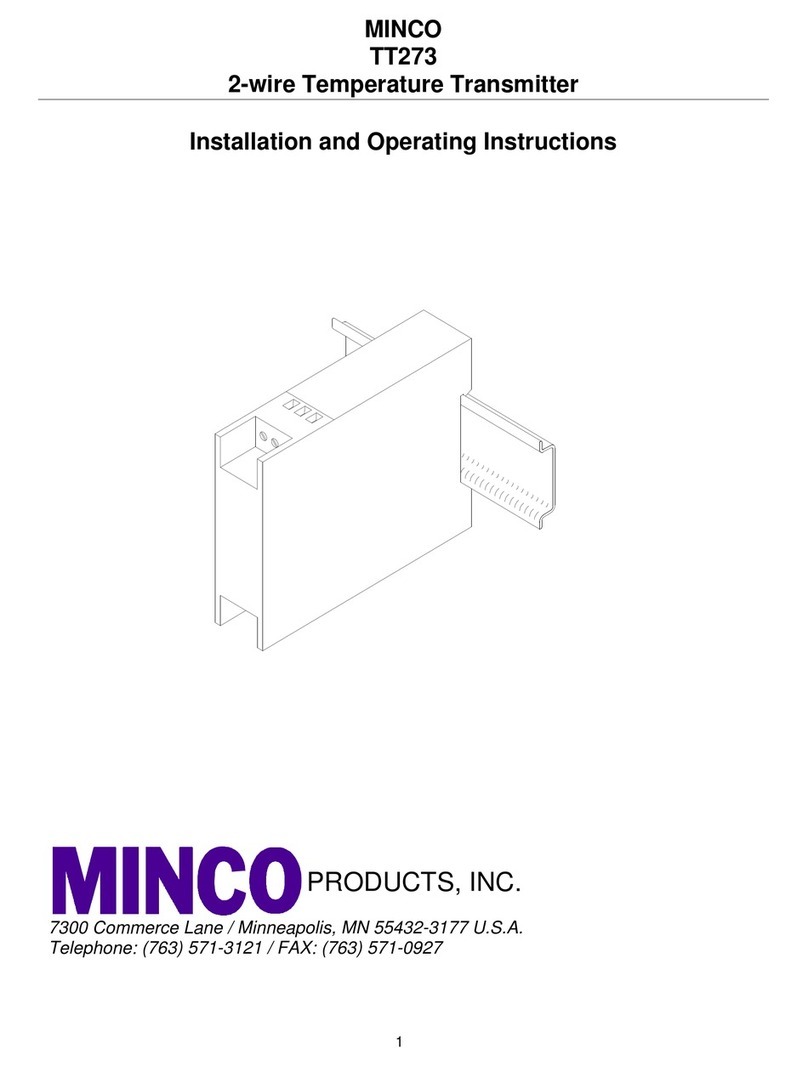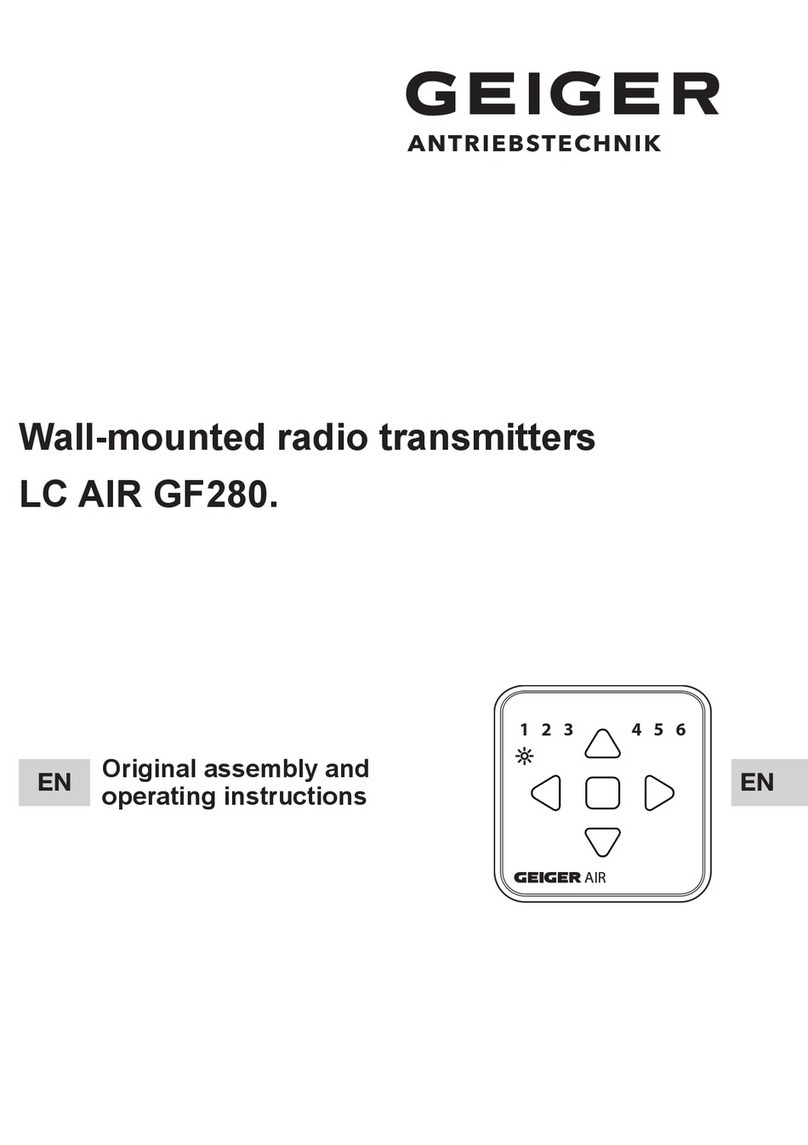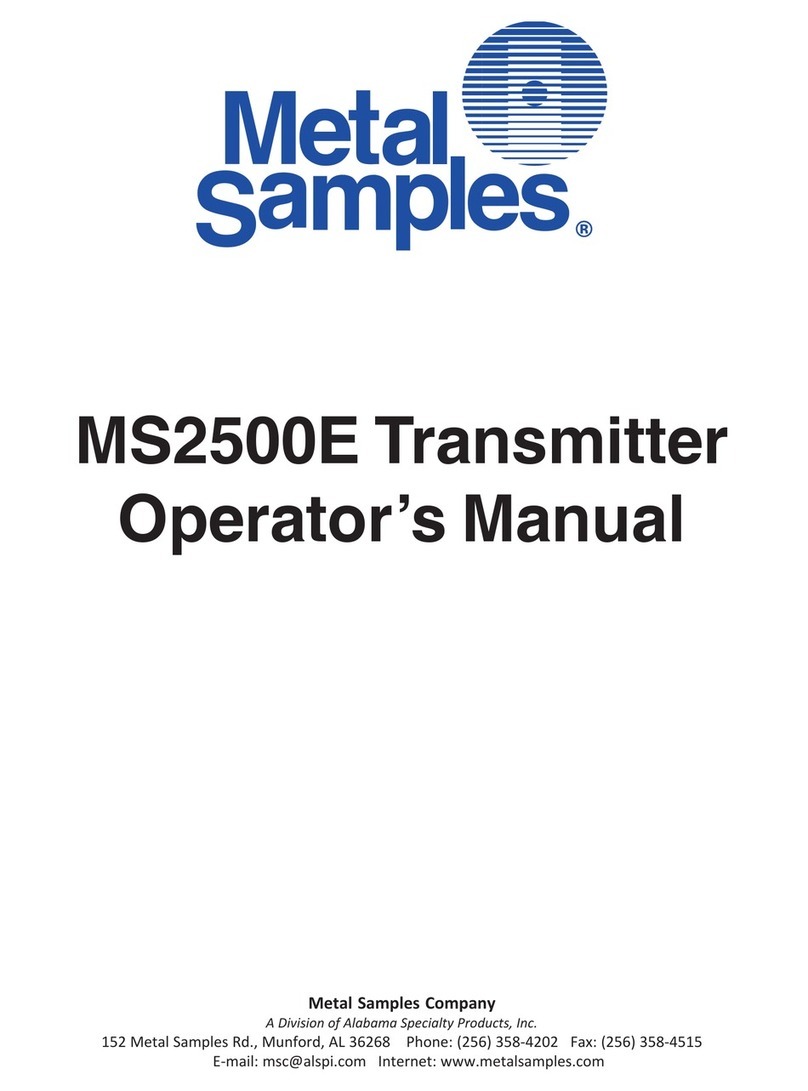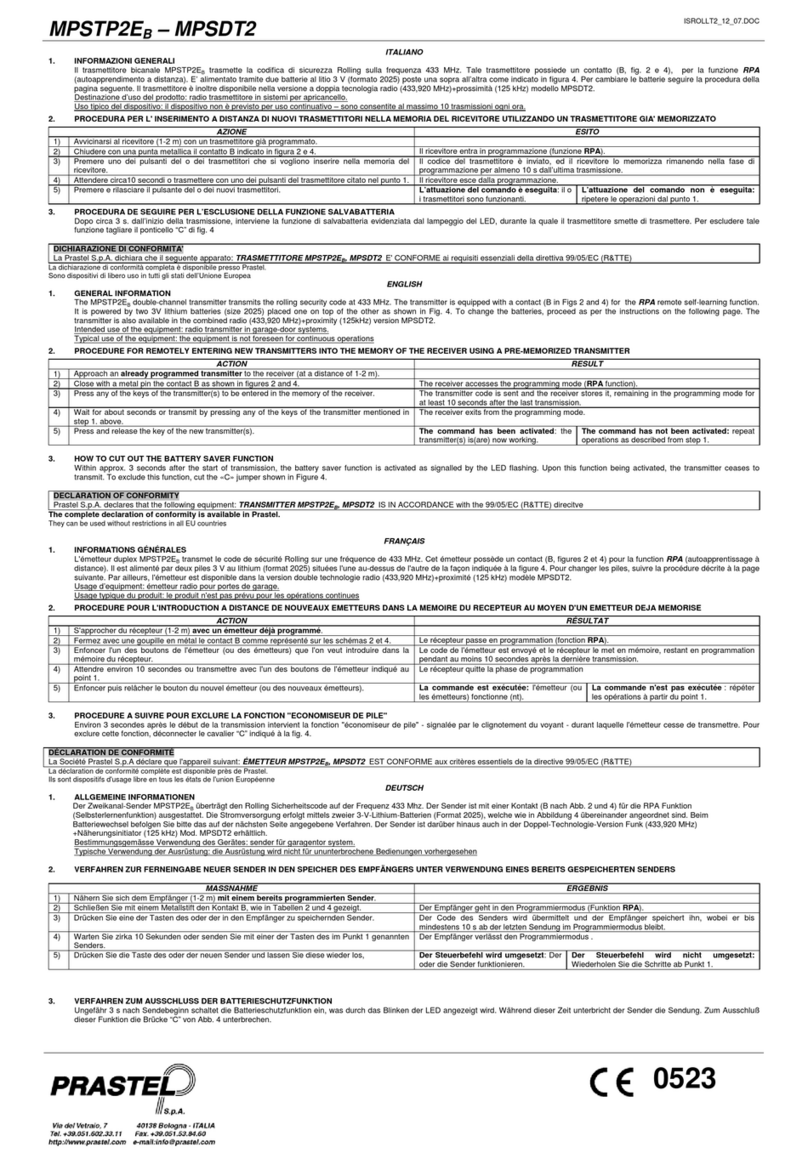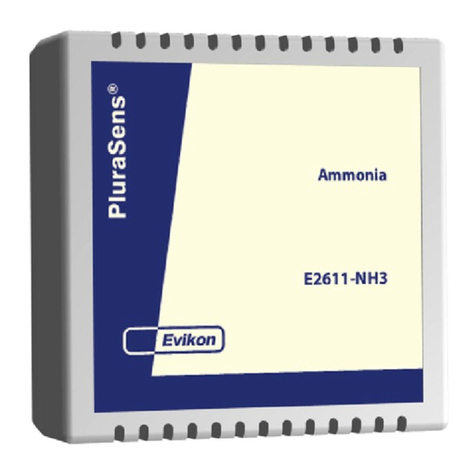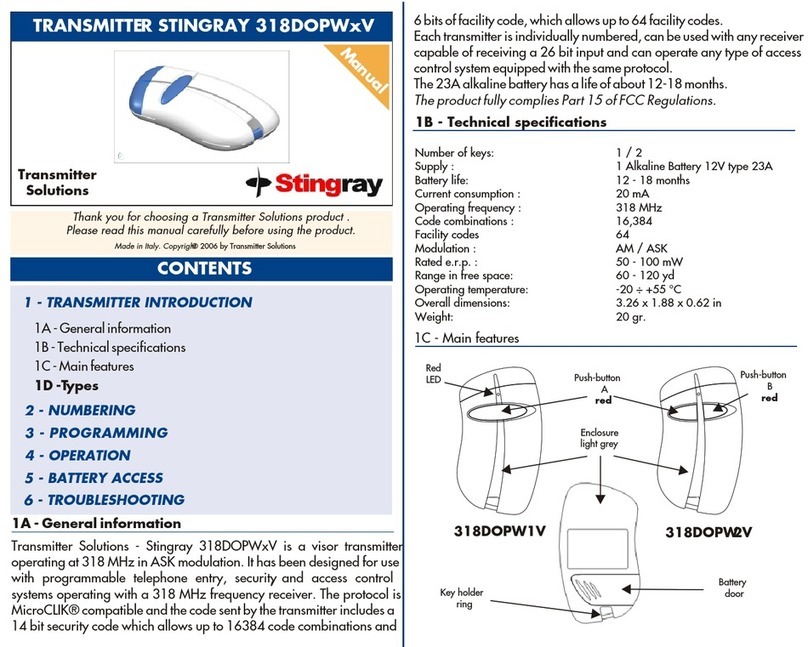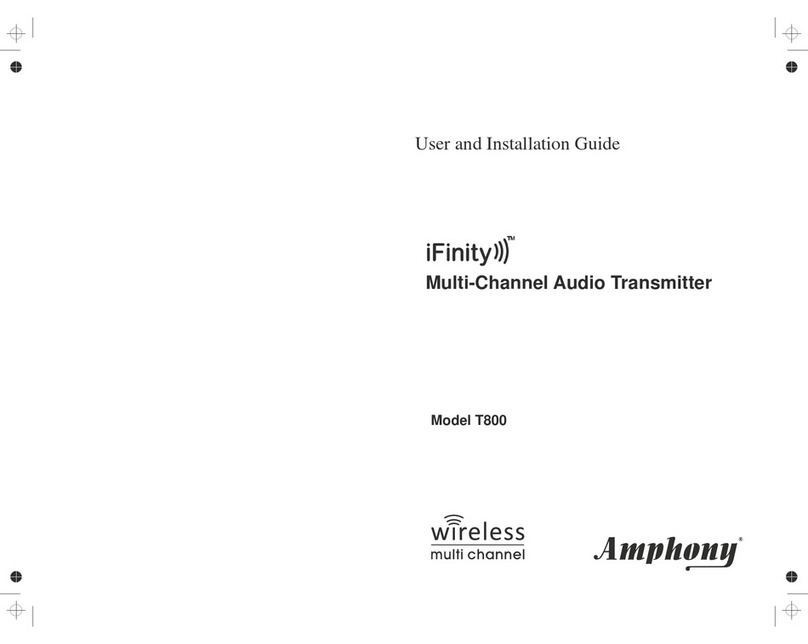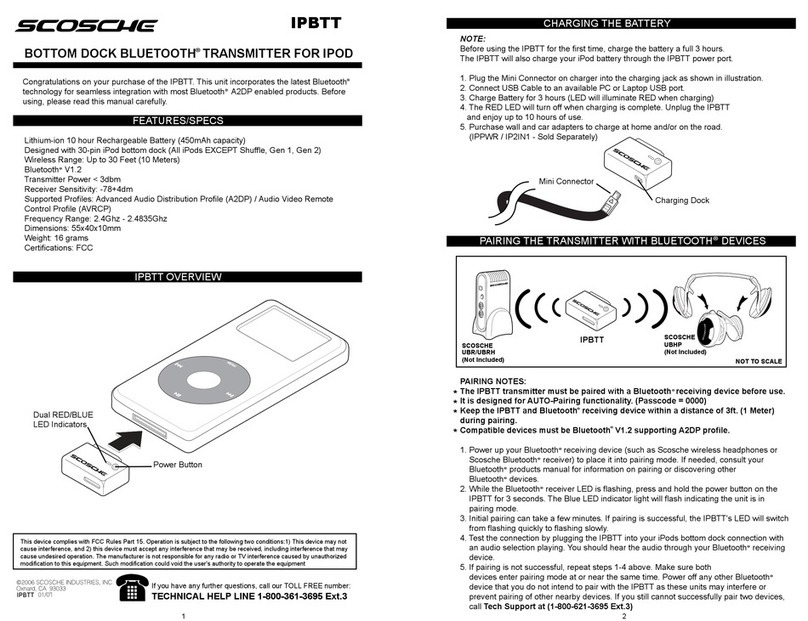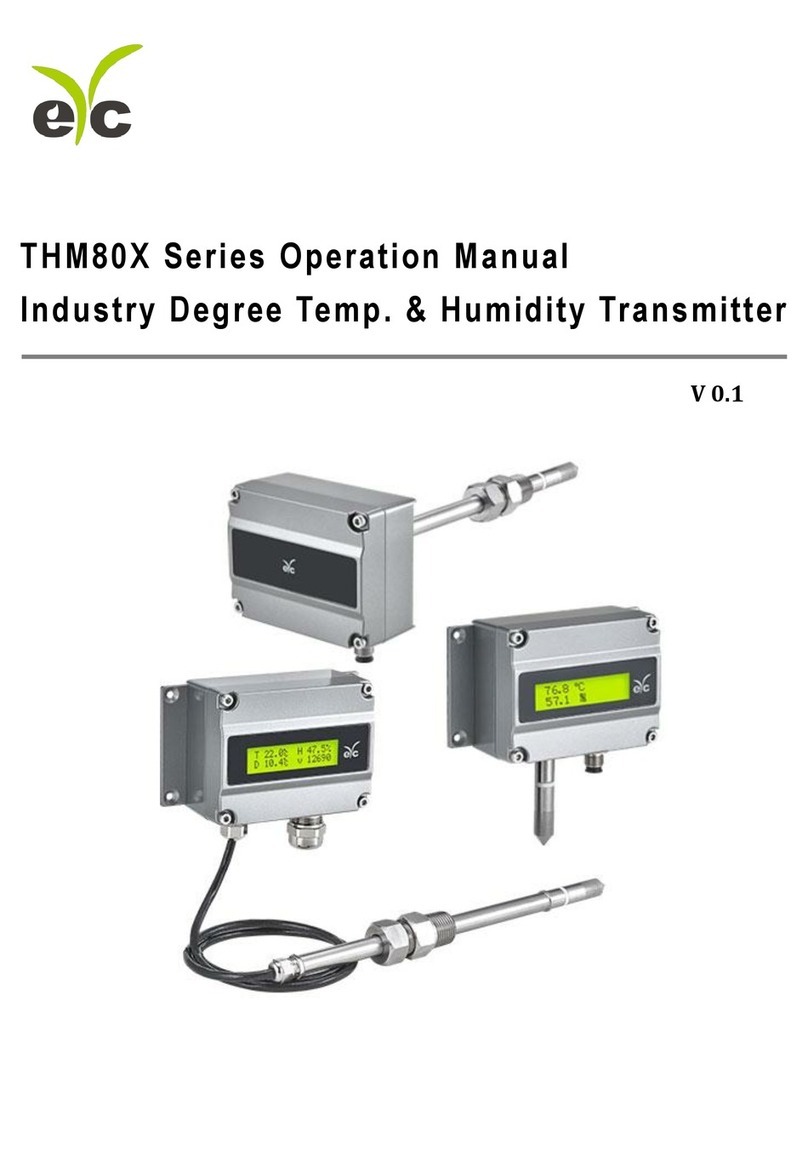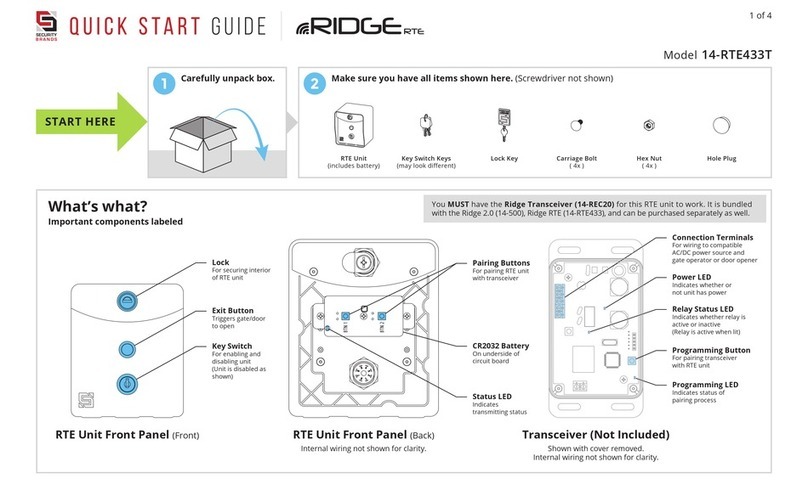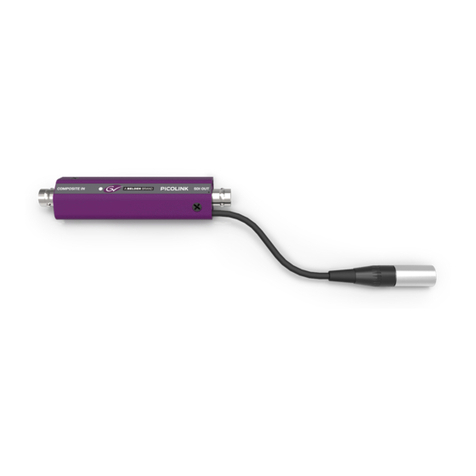Seojin Instech SDT-420 User manual

Displacement Type Level Transmitter
Mar. 2012
(Gunja
(Gunja(Gunja
(Gunja-
--
-Dong) No.288 Dongil
Dong) No.288 DongilDong) No.288 Dongil
Dong) No.288 Dongil-
--
-Ro Gwangjin
Ro GwangjinRo Gwangjin
Ro Gwangjin-
--
-Ku
KuKu
Ku
Tel: 02-2204-8500 Fax: 02-2204-8505
http:// www.seojin.biz
DT-10120050801-SBL
Rev. 2.0

TABLE OF CONTENTS
TABLE OF CONTENTSTABLE OF CONTENTS
TABLE OF CONTENTS
Chapter Contents Page
1 Before installing 2
2 Introduction 4
3 Features 4
4 Principles of operation 5
5 Specifications 9
6 Name Plate 11
7 Installation 12
8 Displacer 16
9 Wiring 17
10 Configuration 21
11 Troubleshooting 34
12 Remote Configuration HHT 375 35

1.
1.1.
1. Before
BeforeBefore
Before I
II
Installing
nstallingnstalling
nstalling
· Read this manual thoroughly and become familiar with it before installing or operating this
Displacement type Level Transmitter (SDT-420).
1.1 Safety Precaution
1.1 Safety Precaution1.1 Safety Precaution
1.1 Safety Precautions
ss
s
· Read the safety precautions carefully before using this instrument.
The safety precautions described herein should be strictly complied with for safety operations and
are classified to DANGER, WARNING and CAUTION.
1.2 Precautions
1.2 Precautions1.2 Precautions
1.2 Precautions during the
during theduring the
during the
I
II
Instal
nstalnstal
nstallation &
lation &lation &
lation & O
OO
Operation
perationperation
peration
1. The information included in this manual is subject to change without prior notice.
2. Check if all specifications are consistent with the products you ordered.
3. Inspect the instrument for any damages that may have occurred during the transportation.
4. For securing an appropriate operation, the ambient temperature should be between 0 ~ 70and
the humidity should be between 0~99%RH(No condensation).
5. Do not install or use this instrument in the location where generates corrosive gases (especially
hazardous gases or ammonia gas) or combustible gases unless the instrument is an explosion
proof type.
6. Do not install or use the instrument in the location where vibration may affect directly to.
7. Do not clean the instrument with organic solvent such as alcohol or benzene, and use a neutral
detergent.
WARNING
WARNINGWARNING
WARNING
1. Where there are any concerns that a small trouble or an abnormal operation can cause
any serious accidents, an appropriate safety protecting circuit should be installed in
order to prevent those serious accidents.
2. Prepare a separate power switch for this instrument.
3. Confirm that the voltage of power source is consistent with the rated voltage of the
instrument.
4. Do not hook up the power cable before completing all wiring connections.
5. User can choose an Explosion Proof type for the installation to a potentially explosive
location so check if the purchased instrument is the Ex-proof type when installing to a
potentially explosive location. Also, a safety barrier should be installed when installing to
a potentially explosive location. (Safety Barrier grounding: 1 Class grounding)
6. Do not disassemble, alter or repair it as they can cause malfunction, abnormal working,
fire or electric shock.
7. Turn the main power switch off before mounting or dismounting this instrument in
order to prevent possible electric shock, malfunction, or breakdown.
8. The using ways that are not designed by the manufacturer may cause damages or
losses on property.
DANGER
DANGERDANGER
DANGER
It is highly recommen
It is highly recommenIt is highly recommen
It is highly recommended not to touch the Input/Output terminal unit directly as it can
ded not to touch the Input/Output terminal unit directly as it canded not to touch the Input/Output terminal unit directly as it can
ded not to touch the Input/Output terminal unit directly as it can
cause an
cause ancause an
cause an electric
electricelectric
electric
shock
shockshock
shock.
..
.

8. Do not install or use the instrument in the location where generates noticeable inductive
interference, electrostatics or magnetic noise.
9. Keep the instrument away from the direct sunlight or radiation heat.
10. Do not use the instrument in a location of which the altitude is more than 2000 meters.
11. In the event of water leaking into the instrument, contact us or a dealer and ask for an
inspection before using in order to avoid any short circuits or fires.
12. To avoid any impact from inductive noises, the input signal line should be in a certain distance
from power lines or load lines.
13. Turn the main power switch off before wiring or exchanging sensors.
14. Do not connect any wire to unused terminals.
15. Verify the terminal polarity then perform the electric wiring correctly.
16. Install the switches or circuit breakers close to the operator in order to allow easy access.
17. Periodical maintenance is recommended to secure the safe operations.
18. Some components are expendable which have their own lifetimes, whereas some parts are
degraded with the passage of time.
19. We offer a two year guarantee for this instrument including its components, if it is properly used.
20. Do not move the Displacer with the Torsion Bar connected.
21. Pay attention to possible shocks during moving or installing it.
22. Try not to let moisture or dust get into the electric circuit.
23. Do not disassemble this instrument.
24. An additional explosion-proof cable gland should be used to the cable entry when installing this
instrument to a potentially explosive location.
25. Additional measures, such as a thermostat, air purging or vent hole should be considered to
prevent dew condensations inside the circuit.
The installation of Displacement Type Level Transmitter (SDT)
The installation of Displacement Type Level Transmitter (SDT)The installation of Displacement Type Level Transmitter (SDT)
The installation of Displacement Type Level Transmitter (SDT)
should always be f
should always be fshould always be f
should always be followed by the instructions on this manual.
ollowed by the instructions on this manual.ollowed by the instructions on this manual.
ollowed by the instructions on this manual.

2.
2.2.
2. Introduction
IntroductionIntroduction
Introduction
· For the safe and efficient operation of various high temperature and high pressure steam drums,
boilers and reactors used in Firepower Plants, Glass & Cement Plants, Petrochemical Plants and Steel
& Paper manufacturing Plants, close monitoring and controlling of the interface level between water
and vapor is very important. As these steam drums are working under extremely high temperature
and pressure conditions, the instruments related to measuring and controlling the level must be
defect-free. Otherwise, minor defects may bring serious damages to the other equipments or
financial losses.
· However the industry had relied on the instruments like Sight Glass or Float Type Level switches and
had experienced many troubles so the demand for the alternative instruments had increased. To
respond to this market demand, Seojin committed to the development of Displacement Type Level
Transmitter based on its experiences and know-how, and finally has succeeded in launching this
model to the market. Our Displacement Type Level Transmitter can assure the reliable operation
even under the harsh circumstance like 200Ꭰf/and 450.
· This Displacement Type Level Transmitter is designed for measuring not only the level of on liquid
but also the interface level between two different liquids. Its operation is based on the buoyancy
principles of Archimedes and it supports remote monitoring by the configuration with PC (With
SEMENS PDM Software) or Universal Hand Held Terminal (HART Field Communicator). This instrument
also supports the conventional way of operation and control so the users can operate and control it
using keypads at the field.
3.
3.3.
3. Features
FeaturesFeatures
Features
· Communication Protocol: HART / SIEMENS PDM.
· Measuring Range: 300 ~ 5000᎖
· Process Temperature: -40 ~ 450
· Process Pressure: 200Ꭰf/
· Output Signal: 2wire Type 4 ~ 20Ꮄ, HART. LCD
· Specific Gravity: 0.5 ~ 1.5
· Accuracy: ±0.5% F.S.
· Fluid ends material: 316SS, PTFE, MONEL, etc.
· Equip with a continuous self-diagnosis function.
· Display various units (%, Ꮄ, , and so on).
· No factory calibration is necessary. By entering the data of density, temperature and measuring
length at the field, this instrument can be started to operate.

4. Principles of
4. Principles of4. Principles of
4. Principles of O
OO
Operation
perationperation
peration
4.1
4.14.1
4.1 Overvie
OvervieOvervie
Overview (Explosion Proof Type)
w (Explosion Proof Type)w (Explosion Proof Type)
w (Explosion Proof Type)
4.2
4.24.2
4.2 Torsion Bar
Torsion BarTorsion Bar
Torsion Bar A
AA
Assembly
ssemblyssembly
ssembly
)LJ
)LJ

4.
4.4.
4.3
33
3
Overview (Intrinsically Safety Type)
Overview (Intrinsically Safety Type)Overview (Intrinsically Safety Type)
Overview (Intrinsically Safety Type)
)LJ

4.
4.4.
4.4
44
4
Displayer Assembly
Displayer AssemblyDisplayer Assembly
Displayer Assembly
ITEM NAME ITEM NAME
1 DISPLAY HOUSING 13 TERMINAL BLOCK COVER
2 COVER PCB 14 THRU CAPACITOR
3 MASK 15 BASE PCB SUPPORT
4 RETAINING RING 16 DISPLAY BRACKET
5 GLASS WINDOW 17 CYLINDER HEAD SCREW M3
6 STOP RING 18 CONNECTOR
7 O RING 19 MAIN BOARD PCB
8 DISPLAY COVER 20 MAIN PCB SUPPORT
9 TERMINAL BLOCK BOARD SUPPORT 21 DISPLAY PCB BOLT
10 O RING 22 LCD BOARD PCB
11 DISPLAY PCB BOLT 23 MAIN PCB BOLT
12 TERMINAL BLOCK PCB 24 DISPLAY PCB
)LJ

4.5 Principles of Operation
4.5 Principles of Operation4.5 Principles of Operation
4.5 Principles of Operation
· The Displacer(Fig3. – ITEM 33)'s buoyancy is transmitted to the Torsion Bar(Fig.2 - ITEM 9)
through the Operating Rod Assembly(Fig2. – ITEM 8) then converted to electrical signals by the
compressive force or tensile force of the Load Cell connected to the bar fixture. The Wheatstone
Bridge Circuit of this load cell is consisted of a thermometer and 4 thin metallic strain gauges. The
voltages generated from the Load Cell is converted into 4~20Ꮄoutput signals of 2 wires by an
amplifier device.
4.5
4.54.5
4.5.1 Principles of
.1 Principles of.1 Principles of
.1 Principles of M
MM
Measuring
easuringeasuring
easuring
· According to the Archimedes' Principle which states that the buoyant force on a submerged
object is equal to the fluid displaced, the submerged displacer of which the shape is cylinder is
used for measuring the level and the density of a fluid and the interface levels between two
different liquids.
· The buoyancy changes in proportion to the changes of a level and this is converted to
measuring values. The displacer needs to be completely submerged for measuring the density or
the interface level.
· The following shows the general formula for calculating the buoyancy applied to the displacer.
4.5
4.54.5
4.5.2 B
.2 B.2 B
.2 Block
locklock
lock D
DD
Diagram
iagramiagram
iagram
Signal
Proportional
To
Buoyancy
Force
Sensor
Calibration
Damping Zero
Calibration
Smart
Smoothing
Characteristic
PV
Customized
Calibration
Damping Factor Linear, Square- root
Extracted or Customized
Physic al
Unit
Measuring
Span
Transfer
Function
Physical Unit Setpoint
Linear, Square- root
Extracted
Measuring
S
p
an
PV
Low Flow
Out Off
mA
Substitute
Value
mA
mA
Display
On/ Off Failsafe
Selection
PV
mA
%
Digital
Output
PV
Analog
Output
AA
7DE OH

5. Specif
5. Specif5. Specif
5. Specifications
icationsications
ications
5.1 Model & Range
5.1 Model & Range5.1 Model & Range
5.1 Model & Range
SDT- 420 / 300 ~ 3,000᎖
5.2 Electric Specifications
5.2 Electric Specifications5.2 Electric Specifications
5.2 Electric Specifications
Power Supply
· General Operating: 12 ~ 30V(No Load)
· Hart Communication: 17.5 ~ 30V
· Hart Loop Resistance: 250 ~ 550Ω(24Vdc)
= (Supply Voltage - 12Vdc) / (22Ꮄ)
· Update Time: 0.1sec
· Output Signal: 4 ~ 20Ꮄdc / HART
· Turn-on Time: 5sec
5.3 Performance Specifications
5.3 Performance Specifications5.3 Performance Specifications
5.3 Performance Specifications
· Reference Accuracy: < 0.5% F.S
· Operation Condition Effects
Ambient Temperature: -10 ~ 60
Zero < 0.1% / 10K
Span < 0.07% / 10K
( 0.1*Max Measure Span/Adjusted Measure Span
± 0.07* Measure Value/Adjusted Measure Span) % / 10K
< -1/ > 60...... Twice value
Humidity Limits: < 99%
Process Temp. Limit: 450
Long Term Stability: < 0.5% of F.S / 6 Month at 20
5.4 Physical Specification
5.4 Physical Specification5.4 Physical Specification
5.4 Physical Specification
Mater
MaterMater
Materials
ialsials
ials
· Wafer Body : 304SS, A105, 316LSS, LTCS
· Torque Tube : 316LSS, Inconel 600
· Displacer : 304, 316L, PTFE, PTFE with 25% Carbon
·Suspension : 316L
· Amplifier Housing : ADC12 Polyurethane Coated

Marking (
Marking (Marking (
Marking (Intrinsic Saf
Intrinsic SafIntrinsic Saf
Intrinsic Safe
ee
ety
tyty
ty ‘
‘‘
‘i
ii
i’
’’
’)
))
)
All units have a rating label, which carries the following important information:
DISPLACEMENT TYPE LEVEL TRANSMITTER
Model : SDT-420
Code : Ex ia IIC T4 IP65
-20ఁTa+60ఁ
Type Approval Standards
Type Approval StandardsType Approval Standards
Type Approval Standards
The unit has EC Type Examination and IECEx certificates issued by INERIS and has been approved to
the following standards:
· IEC 60079-0(2007) – Electrical apparatus for potentially explosive atmospheres
(General requirements)
· IEC 60079-11(2006) – Electrical apparatus for potentially explosive atmospheres
(Intrinsic Safety ‘i’)
· IEC 60529(1999) – Degree of protection provided by enclosures (IP Code)
· Other Reference Standards : ISO, IEC, EN, DIN, NEMA, etc.
BARRIER PA
BARRIER PABARRIER PA
BARRIER PARAMETER :
RAMETER :RAMETER :
RAMETER :
Ui=28V Ii=93mA Li=0.051mH Ci=12.4nF
Ui=28V Ii=93mA Li=0.051mH Ci=12.4nFUi=28V Ii=93mA Li=0.051mH Ci=12.4nF
Ui=28V Ii=93mA Li=0.051mH Ci=12.4nF
Marking
MarkingMarking
Marking ATEX
ATEXATEX
ATEX (Flameproof Enclosure)
(Flameproof Enclosure)(Flameproof Enclosure)
(Flameproof Enclosure)
All units have a rating label, which carries the following important information:
DISPLACEMENT TYPE LEVEL TRANSMITTER
Model : SDT-420
Code : Ex d IIC T6 Gb IP65
-20ఁTa+60ఁ
Certificate No : IECEx KTL 10.0006
INERIS 11 ATEX 0001
Equipment Group and Category II 2G
CE Marking
Notified Body No. ****
Warnings: DO NOT OPEN WHEN ENERGIZED.
POWER OFF TO INSTALL & UNINSTALL
Type Approval Standards
Type Approval StandardsType Approval Standards
Type Approval Standards
The unit has EC Type Examination and IECEx certificates issued by INERIS and has been approved to
the following standards:
EN60079-0 IEC60079-0 General Requirements
EN60079-1 IEC60079-1 Flameproof Enclosure "d"
Special Conditions For Safe Use
Special Conditions For Safe UseSpecial Conditions For Safe Use
Special Conditions For Safe Use
΅΅π ΣΠΔΖΤΤ ఁ ΥΠఁ

6. N
6. N6. N
6. Name
ameame
ame P
PP
Plate
latelate
late
· 2 Name Plates are attached on this transmitter; one is attached on ྙ(The Adjusting Housing),
which includes the information about process conditions such as pressure, temperature, C to C,
flange rating and the size of displacer. Another is attached on ྚ(The Displayer), which includes
Model No., Input Power, Output signal, the date of manufacture and Tag No. The others are hung on
ᐯ(The Adjusting Housing Connector), which includes power, output, pressure, temperature, C to C,
flange rating, size of Displacer, specification & type, certificate number, certificate date, certificate
standards, certificate authority, manufacture date, manufacturer.
ᐭ
ᐮ
OR
OR
Standard Type Intrinsic Safety Type ATEX Explosion Proof Type
ᐯ
Explosion Proof Type
)LJ
)L
J

7. Installation
7. Installation7. Installation
7. Installation
· This transmitter is normally installed directly on top of a vessel or on the side of a vessel using a
displacer chamber.
· Before installing, check if the tolerable pressure and the surrounding temperature are appropriate.
7.1
7.17.1
7.1 When
WhenWhen
When A
AA
Applying to a
pplying to applying to a
pplying to a H
HH
High
ighigh
igh T
TT
Temperature
emperatureemperature
emperature P
PP
Process
rocessrocess
rocess
· The allowable surrounding temperature should be considered when applying to a high
temperature process. For example, when this instrument is applied to the concentrated process
that has high thermal capacity (such as saturated vapor of 300 degrees Celsius) or if the Water
Assembly is mounted on a heating jacket or a heater of the heat media of which the temperature is
more than 300 degrees Celsius, the surrounding temperature of the Adjust Housing and the
Displayer should be less than 50 degrees Celsius. In case of exceeding the maximum allowable
surrounding temperature(Adjust Housing: 85/Displayer: 70), all parts that have radiant heat
such as Water Assembly, Chamber, Drum and Vessel should be insulated so that the radiant heat
would not be transmitted to the Adjust housing and the Displayer. The Adjust housing and the
Displayer should not be exposed to the direct sunlight.
7.2
7.27.2
7.2 To
ToTo
To I
II
Install on
nstall onnstall on
nstall on T
TT
Top of a
op of aop of a
op of a V
VV
Vessel
esselessel
essel D
DD
Direc
irecirec
irectly
tlytly
tly
· As shown in the picture, mount the instrument on top
of a vessel using the connection flange.
· If levels fluctuate a lot, a protection cage which has a
vent should be prepared.
· The clearance between the protection cage and the
displacer should be in 5~10᎖.
7.3
7.37.3
7.3 To
To
To
To I
II
Install to the
nstall to thenstall to the
nstall to the E
EE
External
xternalxternal
xternal C
CC
Chamber
hamberhamber
hamber M
MM
Mounted on the
ounted on theounted on the
ounted on the
S
SS
Side of a
ide of aide of a
ide of a V
VV
Vessel
esselessel
essel
· The Chamber should be mounted exactly perpen-
dicularly and appropriate bolts & nuts and gaskets
should be used.
)LJ

7.4 Precautions for
7.4 Precautions for7.4 Precautions for
7.4 Precautions for t
tt
the
hehe
he I
II
Installation on
nstallation onnstallation on
nstallation on t
tt
the
hehe
he S
SS
Side of a
ide of aide of a
ide of a V
VV
Ves
eses
essel
selsel
sel
· Compensation of the density error
In spite of every efforts to keep the
temperature, the water or steam
kept in the pipe or the chamber
which is connected to the side of a
vessel tends to be cooled down
easily by the influences of the
outside temperature, which causes
the water or steam in the pipe or the
chamber to have comparably higher
density than the water or steam
preserved in the vessel. As a result
of that, the specific gravity of the
water or steam in the chamber (pipe)
becomes higher and this can bring
level differences up to around 150᎖.
This can’t be overcome by merely
changing the pipe shape or taking measures to keep the temperature, and it will become an obstacle
to get accurate level data.
· In that case, the below explained method can be considered to suppress the density (specific
gravity) error within 20᎖.
· As shown in the picture above (Fig. 8), expose the upper branch of the steam pipe to the air in part
so that the Latent Heat of Condensation generated by the liquefaction of the steam can be
transmitted to the water preserved in the water vessel, and this latent heat of condensation makes
the water temperature go up and can minimize the temperature difference, which eventually makes
the measurement error minimize. The pipes and lagging materials should be installed to have
slopes like the Fig. 8.
7.5 Installation Procedure
7.5 Installation Procedure7.5 Installation Procedure
7.5 Installation Procedure
7.5.1
7.5.17.5.1
7.5.1 Preparation
PreparationPreparation
Preparation
1) Check the Tag No., specifications and the Displacer Tag No.
2) Check the items listed below.
ྙSENSOR BODY 1SET - Check the Tag No.
ྚDISPLACER 1SET – Check the Tag No., length and so on.
ྛBLIND FLANGE 1SET – Check the flange rating, size, material and a vent plug.
ྜGASKET 2PCS – Check the rating, size and material.
ྜྷSTUD BOLT/NUT 4 OR 8SETS - Check the length, material and so on.
)LJ

7.5.2
7.5.27.5.2
7.5.2 Installation
InstallationInstallation
Installation
Step 1
Step 1Step 1
Step 1:
::
: To
ToTo
To A
AA
Assembl
ssemblssembl
ssemble
ee
e the
thethe
the S
SS
Sensor
ensorensor
ensor B
BB
Body on to
ody on toody on to
ody on to
the
thethe
the
C
CC
Connecti
onnectionnecti
onnection
onon
on
F
FF
Flange
langelange
lange
(Refer to Fig.
(Refer to Fig.(Refer to Fig.
(Refer to Fig.9
99
9)
))
)
· Put a proper gasket on top of the
connection flange.
· Put the torsion bar guard on the
connection flange and then insert a stud
bolt into the position bracket to secure
the safety.
· Insert the stud bolt toward the
connection flange from above the
position bracket, and assemble with a
nut.
· Make sure that enough length of nut thread is engaged to the stud bolt.
· Locate the gasket and the sensor body to be the center of the connection flange.
Step 2:
Step 2:Step 2:
Step 2: To
ToTo
To A
AA
Assembl
ssemblssembl
ssemble the
e thee the
e the
D
DD
Displacer
isplacerisplacer
isplacer
(Refer to
(Refer to(Refer to
(Refer to Fig.
Fig.Fig.
Fig. 10
1010
10)
))
)
· Put the displacer into a chamber through
the space of the operating rod.
· Insert the connector link hook into the
groove of the operating rod’s hole then
rotate the connector link hook to lock
(see Fig.10).
Note
NoteNote
Note
In case of the instrument of which the
displacer length is less than 800᎖,
assemble the displacer with the operating rod before mounting the connection flange as it is not
long enough to pass through the operating rod.
Step
StepStep
Step 3
33
3:
::
: To
ToTo
To A
AA
Assembl
ssemblssembl
ssemble
ee
e the
thethe
the B
BB
Blind
lindlind
lind F
FF
Flange
langelange
lange
(Refer to Fig.1
(Refer to Fig.1(Refer to Fig.1
(Refer to Fig.11
11
1)
))
)
· Put a gasket on the serrated face of the torsion
bar guard.
· Place the blind flange on top of that and position
the bolt-holes to those of the connection flange.
· A vent plug should be prepared on the blind
flange.
)LJ
)LJ
)LJ

Step
StepStep
Step 4
44
4:
::
: To
ToTo
To F
FF
Fix
ixix
ix the
thethe
the S
SS
Stud
tudtud
tud B
BB
Bolt &
olt &olt &
olt & N
NN
Nut
utut
ut
(Refer to
(Refer to(Refer to
(Refer to Fig.1
Fig.1Fig.1
Fig.12
22
2)
))
)
· Insert the stud bolts into the bolt holes of the flange and then tighten with the nuts using
fingers (do not use a tool).
· Remove the nut fitted to the position bracket and tighten the stud bolts so that the connection
flange and the blind flange would be assembled.
· The number of stud bolts depends on the flange size.
· When tightening the stud bolts, tighten them one by one gradually with constant torque in
diagonal cross pattern, not tightening at once. Using a torque wrench is recommended.
Appropriate Torque
Stud Bolt M16 M20 M24 M27 M30 M36
Torque N·m 95 185 310 450 630 1080
Torque Ꭰ·᎗969 1887 3162 4590 6026 11016
7DE OH
)LJ

8.
8.8.
8. Displacer
DisplacerDisplacer
Displacer
· Verify if the specification of the displayer is relevant to the displacer. The displayer is calibrated at
the factory according to the requested specification before the shipment. Every displacer includes
the tag number or the length on it.
8.1
8.18.1
8.1 Applying Pressure
Applying PressureApplying Pressure
Applying Pressure
· The pressure applied to the displacer should be designed according to the pressure of the
pressure vessel when it would be in the highest temperature. The material of displacer depends on
the kind of process or the customer’s request. The table below shows the standard specification
by each measuring range.
Material 316L
Displacer Length φVol. Weight PN
ΦVol. Weight PN
L ᎖᎐N ᎠΗ/bar ᎖᎐N ᎠΗ/bar
᎖
350 60,3 1000 19 1.94 100 42,4 500 18 1.84 250
500 48,3 920 17 1.73 100 42,4 710 24 2.45 250
750 42,4 1060 21 2.14 100 33,7 670 21 2.14 250
1000 33,7 890 17 1.73 100 26,9 570 18 1.84 250
1200 33,7 1070 20 2.04 100 26,9 680 22 2.24 250
1500 26,9 850 16 1.63 100 21,3 540 17 1.73 250
1800 26,9 1020 19 1.94 100 21,3 640 20 2.04 250
2000 26,9 1140 21 2.14 100 21,3 710 22 2.24 250
2500 21,3 890 20 2.04 100 17,2 580 16 1.63 250
3000 21,3 1070 24 2.45 100 17,2 700 23 2.35 250
inch
14 60,3 1020 20 2.04 100 42,4 510 18 1.84 250
32 42,4 1150 23 2.35 100 33,7 730 23 2.35 250
48 33,7 1090 20 2.04 100 26,9 690 22 2.24 250
60 26,9 870 16 1.63 100 21,3 540 18 1.84 250
72 26,9 1040 19 1.94 100 21,3 650 21 2.14 250
84 26,9 1210 22 2.24 100 21,3 760 23 2.35 250
96 21,3 870 20 2.04 100 17,2 570 16 1.63 250
120 21,3 1090 25 2.55 100 17,2 710 24 2.45 250
7DE OH

9
99
9. Wiring
. Wiring. Wiring
. Wiring
9.1
9.19.1
9.1
To
ToTo
To C
CC
Connect
onnectonnect
onnect the
thethe
the S
SS
Signal
ignalignal
ignal L
LL
Line
ineine
ine (Stan
(Stan(Stan
(Standard Type)
dard Type)dard Type)
dard Type)
· Loosen the T.B Cover (Fig.4 – ITEM 13) of the displayer and then insert the line through the cable
gland (PG13.5).
· 2-Core Shield Wire should be used for the signal line.
· In case of installation into an explosive area, an Explosion Proof Cable Gland (not supplied) must
be used instead of the Standard Cable Gland. For the standard cable gland, PG13.5 can be applied
and the thread size can be selected from 1/2NPT, 1/2PF, 1/2PT, and M20 according to a
customer’s request.
9.1.1
9.1.19.1.1
9.1.1 To
ToTo
To C
CC
Connect
onnectonnect
onnect the
thethe
the S
SS
Signal
ignalignal
ignal L
LL
Line
ineine
ine (Remote Type)
(Remote Type)(Remote Type)
(Remote Type)
)LJ
)LJ

9.2
9.29.2
9.2 Grounding
GroundingGrounding
Grounding
· The instrument should be connected to a ground terminal
when there is any concern of influence by electromagnetic
waves or noises, or electromagnetic fields.
· Even if a non-conductivity gasket is used, the ground
connection must be done between the connection flange and
the torsion bar guard.
· The displayer is designed to protect itself against reverse polarity.
· Using a Twisted Pair Cable (22AWG min) is recommended to maintain the best performance.
· Installing the displayer near an alternating-current power supply or switching system should be
avoided.
· The ground of the instrument should be connected to the surface of the earth.
· In case of a Shield Cable, the shield should be grounded at the power supply ground only.
)LJ

9
99
9.3 W
.3 W.3 W
.3 Wiring
iringiring
iring D
DD
Diagram
iagramiagram
iagram
Note
NoteNote
Notes
ss
s
· The cable impedance is defined to the
maximum length possible to do the digital
communication, however using low
impedance’s cable is recommended. mG
SG he maximum connection length
between two points of 250Ω
Load and the
Single Twisted Cable 22AWG-207 pf/m is
approximately 1000m.
· Provided that the maximum connection
length of the analog signal is restricted by
the loads of current loop (the cables and
instrument connected).
. To obtain the 4/20Ꮄoutput signal, the
lowest supply voltage should be determined
as a function related to the load relation. The
related formula is as follow.
Supply Voltage = 22ᎴዖR + 12VDC ---- (FM. 2)
Additional
AdditionalAdditional
Additional I
II
Information
nformationnformation
nformation
· At least 250Ωshould be loaded on the loop for HART communication.
· In case of multi-drop connection, the load to the resistance is equal to 4Ꮄx N (the number of
instruments connected).
· Sufficient power should be supplied.
( Supply Voltage = 250 x N * 22Ꮄ+12Volt )
),*
7DE OH
Table of contents
Other Seojin Instech Transmitter manuals

